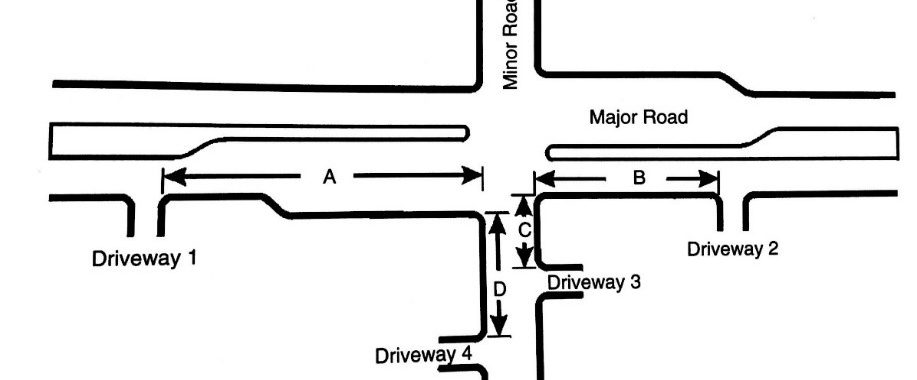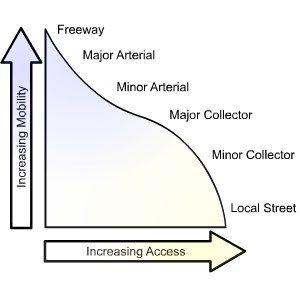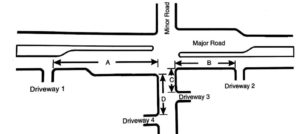The New Jersey Department of Transportation (NJDOT) is responsible for administering an access management policy for the state highway system. The Federal Highway Administration (FHWA) defines access management as “the proactive management of vehicular access points to land parcels adjacent to all manner of roadways. Good access management promotes safe and efficient use of the transportation network.”
Key components of an access management code include access spacing, driveway spacing, safe turning lanes, median treatments, and right-of-way management. While New Jersey’s access management code is highly regarded, it only applies to state highways and not local roads. Local authorities in New Jersey do not have uniform access management codes, regulations, or standards for local roads. This creates a gap in policy for how to address the issues that arise when new developments take place on local roads near intersections with state routes or when state highway improvements are required near intersections with local roads.
To address these issues, the NJDOT Bureau of Research solicited a research study of local access management regulations. The primary research objective was to identify and recommend strategies, tools, and guidelines to facilitate access management on local roads (i.e., county and municipal) intersecting and/or impacting state highways in New Jersey.
The selected research team sought to evaluate how other state DOTs address access management on local roads near state highways and explore how New Jersey local government and transportation agency officials perceive these access management issues between state and local jurisdictions
The research team carried out several tasks. First, they compiled a literature review of local access management drawing upon resources from state DOTs, the FHWA, the Transportation Research Board (TRB), local governments, among others (see Figures 1 and 2). Next, they organized and facilitated discussions with a stakeholder committee of professionals in New Jersey (e.g., municipal, county, and MPO engineers and planners) with experience addressing access management. The team conducted structured interviews with state DOTs from 13 different states, including California, Colorado, Virginia, and Pennsylvania. NJ local government officials were reached through an online survey to gather information on current practices, issues, and relevant case studies. The researchers conducted case study analyses of specific problematic issues at intersections of local roads and state highways in New Jersey. Four site locations were selected based on the availability of data, severity of issues, geographic and land use patterns, and the relative difficulty for access management implementation based on the current system.
The interviews with other state DOTs focused on several themes, including the basis and scope of authority given under current access management laws and regulations; issues related to the development of corner lots; proactive steps taken to avoid access management issues; and recommendations for developing and implementing access. From the interviews with the state DOT officials, the research team gleaned that there is substantial variation on access management approaches. Similar to New Jersey, other State DOTs are mostly focused on
state highways, although many acknowledged facing local-road issues. The team uncovered some best practice strategies that could be pertinent to New Jersey, including the development of corridor agreements between local governments and state DOTs; training local government professionals on access management; establishing communication channels between local offices of state DOTs and local governments; and funding local governments to develop their own access management guidelines and standards.
Stakeholder meetings and surveys of local New Jersey officials revealed broad support for advancing local access management guidelines. Among those surveyed, 27 percent said the local agencies that they served had formal or informal access management guidelines and 60 percent said local access management standards similar to the state highway code would be beneficial. However, key barriers were also identified, including the cost and availability of training. Local officials generally were not in favor of extending NJDOT’s authority beyond the State Highway System to county and local roads, and preferred initiatives from NJDOT to local governments that involved dedicated funding, improved coordination or dialogue, or technical assistance.
Based on the literature review and survey feedback, the research team offered for consideration to NJDOT and local governments some criteria for intersections between state highways and local roads where no local access code or guidelines are available (see Table 1).
The research team also recommended that NJDOT:
- Develop project-specific access management criteria for intersections between state and local roads in highway improvement projects, which will work to communicate early to local agencies and property owners if they may lose parking, road access, right-of-way, etc.
- Provide assistance via funding and training to encourage local governments to develop their own access management guidelines consistent with state code yet with more flexibility to their local roads.
- Provide incentives for local governments to establish and apply access management policies and guidelines (using a similar approach that has been used to encourage Complete Streets policy adoption and implementation training).
- Adopt proactive measures such as corridor agreements with local governments at corridors with highway improvement projects in the next 5 or 10 years according to the state highway improvement plan of local MPOs and NJDOT and specify the spacing criteria for intersections between state and local roads on selected corridors.
- Establish communication channels between divisional offices of NJDOT and local governments so that all parties are aware of projects early on.
- Continue working with the stakeholder committee established for the research study to foster dialogue between NJDOT and local governments on access management
Table 1 – Criteria of Access Spacing and Corner Clearance based on Posted Speed Limit
| Criteria | Agency | Posted Speed Limit (mph) | ||||||
| 25 | 30 | 35 | 40 | 45 | 50 | 55 | ||
| Minimum Access Spacing Peer State DOTs | Minimum Access Separation (feet) | |||||||
| NJDOT(C) | 105 | 125 | 150 | 185 | 230 | 275 | 330 | |
| Peer State DOTs | 125-245 | 125-245 | 125-250 | 245-305 | 245-440 | 440-660 | 440-660 | |
| AASHTO Sight Distance |
280 (240*) |
335 (290) |
390 (335) |
445 (385) |
500 (430) |
555 (480) |
610 (530) |
|
| TRB-Manual** | 330 | 330 | 330 | 330 | 660 | 660 | 880 | |
| NJ Local Agencies | 150-300 | 200-350 | 250-425 | 300-475 | 350-525 | 400-600 | 400-600 | |
| Minimum Corner Clearance | Minimum Distance from Corner (feet) | |||||||
| NJDOT(C) | 50 | 50 | 100 | 100 | 100 | 100 | 100 | |
| Peer DOTs | Same as Access Spacing | |||||||
| NJ Survey |
Same as Access Spacing |
|||||||
Notes: (C) stands for Code/Regulations/Ordinance; (G) Stands for Guidelines/Manual/Standards; * for right-turn-only access points with median blockage; ** TRB Access Management Manual.
The research team also suggested some future work items to further advance implementation. Notably, the development of semi-automated screening tools and GIS overlays could assist in the identification of problematic locations based on state or local intersection spacing criteria. This could help expedite the design process and facilitate proactive communications and problem solving between NJDOT and local governments. Additionally, NJDOT could establish a co-training program for their related departments and local agencies to deliver needed training on general knowledge, prevailing standards and design concepts, institutional procedures, and real-world practice on past state and local access management projects. Based on this report, there is clear evidence of strong support across local and state officials as NJDOT looks to implement these recommendations and further study how to improve current practices.
Sources:
FHWA. “What Is Access Management?” February 15, 2017. https://ops.fhwa.dot.gov/access_mgmt/what_is_accsmgmt.htm
Jin, Peter J., Devajyoti Deka, and Mohammad Jalayer. “Local Access Management Regulations – Technical Brief.” 2019. FHWA-NJ-2018-003 TB
Jin, Peter J., Devajyoti Deka, and Mohammad Jalayer. “Local Access Management Regulations – Final Report.” 2019. FHWA-NJ-2018-003
Williams, Kristine M., Vergil G. Stover, Karen K. Dixon, and Philip Demosthenes. Access management manual. 2014. https://trid.trb.org/view/1341995



